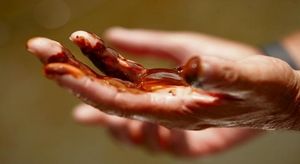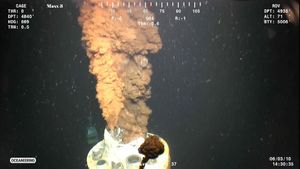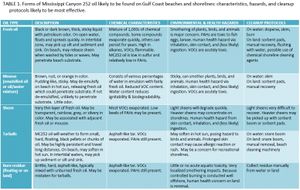Characteristics of Deepwater Horizon oil
Oil spilled from the Deepwater Horizon wellhead has been accumulating in the environment of the Gulf of Mexico since April 20. This document describes the potential forms the oil may take over time as it weathers and degrades; its chemical makeup; its hazards to humans and the environment, especially on beaches and land; and the cleanup protocols most likely to be effective in removing it. Table 1 summarizes this information.
Contents
Chemical nature of the oil
Mississippi Canyon Block 252 (MS252) oil is a South Louisiana sweet crude oil (crude oil is termed sweet if it is low in sulfur). Like all [[crude oil]s], MS252 oil is a complex mixture of thousands of chemical compounds. Of those thousands of compounds, several classes are of special importance in considering persistence and toxicity in the environment. Compared with other crude oils, MS252 oil is relatively high in alkanes. Because alkanes are made up of single-bonded carbon chains that microorganisms can readily use as a food source, MS252 oil is likely to biodegrade more readily than [[crude oil]s] generally. MS252 oil is less toxic than crude oils generally because it is relatively much lower in polyaromatic hydrocarbons (PAHs). PAHs are highly toxic chemicals that tend to persist in the environment for long periods of time, especially if the spilled oil penetrates into the substrate on beaches or shorelines. Like all crude oils, MS252 oil contains volatile organic compounds (VOCs) such as benzene, toluene, and xylene. Some VOCs are acutely toxic but because they evaporate readily, they are generally a concern only when oil is fresh.
Weathering processes
As MS252 oil reaches the surface and spreads out across the water, its lighter components, including VOCs, soon evaporate, leaving heavier components behind. Some of the remaining MS252 oil will become sheen, a very thin layer of floating oil (less than 0.0002 inches or 0.005 mm) that can be transparent, grey, silver, or rainbow-colored. MS252 oil will also mix with water to form a sticky, pudding-like water-in-oil emulsion, or mousse, typically brown, reddish, or orange in color. Typically, crude oil emulsifies on the sea surface as winds and Waves mix it with water, but MS252 oil also appears to be incorporating water as it rises to the surface through 5,000 feet of water. Winds and Waves tear oil and mousse patches into smaller pieces, eventually producing tarballs. MS252 tarballs typically are in the form of small, hard, black pellets. Tarballs can be very persistent in the marine environment.
Hazards and cleanup methods
MS252 oil poses physical and chemical hazards to people and the environment. On beaches and land, fresh or emulsified oil can smother plants, birds, and animals and can create a skin contact hazard for people. VOCs can pose an inhalation hazard to people working near fresh oil, sheen, or mousse. PAHs can cause a persistent environmental hazard if the oil penetrates substrates or is not removed from beaches. A variety of standard cleanup protocols are appropriate for removing MS252 oil from beaches, shorelines, and adjacent waters (see Table 1).



